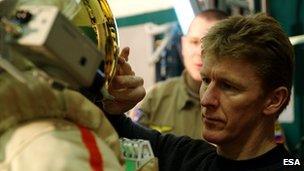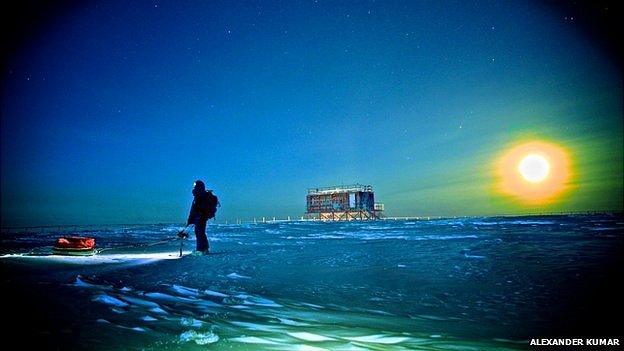Viewpoint: When will we send humans to Mars?
- Published

In the first instalment of a two-part feature, Dr Alexander Kumar - who has been overwintering at Concordia Station, Antarctica - examines what it would take to send humans to Mars, and what lessons we can learn from similar environments on Earth. Read the second part here.
Just how far are we from mounting a crewed mission to the Red Planet?
It's a question I ponder as I stare into a powerful telescope and see a reddish hue in the surrounding darkness.
I have been overwintering at the French-Italian outpost of Concordia station in Antarctica, which is also used to study how humans might one day survive a trip to the Red Planet.
My eyes begin to freeze and my eyelashes become matted together with ice. I dig my hands deeper, further into my pockets seeking warmth.
It strikes me that it's a good metaphor for the astronomical amounts of money that would be required to finance the planning and preparation of such a mission. And that is only the first of many difficult challenges.
I bounce back across the plateau towards the station - my home from home - and look at my thermometer. The outside temperature has fallen below -75C (-99.9C wind chill, the extreme limit of its scale) again.
Residing at 3,800m equivalent altitude, I take a deep breath of air containing just two-thirds the amount of oxygen available at sea level.
Inside the station, the window is frozen over and it remains dark outside, as it has done 24 hours a day for the past three months.
My GPS device identifies that I am "off road". Concordia is in the coldest, darkest and most extreme environment on our planet.
Mars on Earth
Living here is the closest anyone can come to living on the surface of another planet. Despite significant differences in surface gravity and atmospheric pressure, the average Martian surface temperature is around -55C (-67F), similar to our extreme cold temperatures at Concordia.

Tim Peake says that keeping healthy will be a key challenge on any Mars mission
It is for these reasons that such space analogue environments, including Antarctica, Devon Island and Haughton Crater among others, continue to be of great interest to space research agencies in planning future missions.
My research aims to understand how far we can push humans, particularly in regard to extreme physiology and psychology. Space analogue environment research aims to identify challenges and find solutions that will one day help to send a manned mission to Mars, and more importantly, see it safely return.
The overall challenge of sending a manned mission to Mars is a jigsaw puzzle. Success is only possible using international collaboration to make use of all the pieces of research.
This would incorporate the international lessons learnt from astronauts onboard the International Space Station (ISS), the space shuttle and such analogues as the European Space Agency's Mars 500 mission and Concordia, through to physiological lessons learnt in intensive care and medicine.
Some of the principal challenges include dealing with cosmic rays in space, surface radiation on Mars, storms of dust or "fines" (particles that are smaller than dust), the effects of weightlessness and human factors including psychological issues.
Over the past year, I have been in contact with Tim Peake, the UK's only current astronaut-in-training, who directs me towards the physical factors associated with long-term space travel.
"Remaining healthy will be the greatest challenge for an astronaut travelling to Mars, both physically and mentally," he told me.
"The space environment is harsh on the human body and astronauts must maintain good bone density, muscle mass and cardiovascular fitness in order to be able to effectively work in Martian gravity after an extending zero gravity transit.
"The stepping stones that mark our progression towards a manned Mars mission may incorporate trips to asteroids, the Moon, Lagrange points in deep space or even the moons of Mars itself."
Inspiring missions
The Mariner-4 spacecraft performed our first fly-past Mars in 1965. Mars-2 and later Mars-4 landers marked our first physical links to its surface, beaming back images that inspired the imagination and conjured the possibility of Martian life.
Exemplified by the loss of Beagle 2, failure in sending spacecraft and orbiter missions to Mars has been a common curse in reaching the Red Planet or its surface.
Despite such losses, a US$2.5bn creation was born, built and launched in 2011. On 6 August this year, Nasa's Mars Science Laboratory (MSL) rover finally penetrated Mars' thin atmosphere and landed safely in Gale Crater.
The mission's scientists hope that it will forge an exciting new chapter in Mars exploration; unlocking more secrets about the Red Planet's history.
Upcoming future planned projects to Mars, including the InSight and Mars Geyser Hopper missions are waiting in line, alongside projects from other countries such as India and China which have started to make their own plans.

Antarctica could teach us lessons about surviving on a trip to Mars
We have never attempted a return trip; it has all been one-way exploration. Overcoming this challenge seems the next natural step and a crucial consideration for sending a manned mission.
Shared common projections predict a manned mission to Mars will happen, eventually.
Romain Charles, one of the crew members Esa's Mars 500 isolation study to simulate a 520-day return mission to the Red Planet, says: "I am sure that humans will colonise Mars and the Moon. The big question is 'when'."
Tim Peake adds: "All of this will take time and I think the earliest opportunity for humans to visit Mars would be the 2030s."
In sharing his reasons for becoming an astronaut, Mr Peake lists "a natural curiosity, love of challenges and problem solving throughout his career, wanting to explore limits and boundaries". He reiterated that "our knowledge and presence in space is playing a vital role in our future".
Like others, he believes that "a manned Mission to Mars should be mankind's long-term goal" and acknowledges that to achieve this "will require long-term political and financial commitment and will only be successful as part of an international collaboration".
Armstrong's view
Earlier this year, in response to the budgetary and ambition cuts in Nasa, the late commander of Apollo 11, Neil Armstrong, expressed his sadness at the situation.
"Some question why Americans should return to the Moon. 'After all,' they say 'we have already been there.' I find that mystifying. It would be as if 16th century monarchs proclaimed that 'we need not go to the New World, we have already been there'."
This year marked the first private supply flight to the ISS by Space X's Dragon cargo capsule. Where government resources have been cut, the grass has grown greener on the other side in the private sector - nurtured by the prospect of space tourism. However space tourism remains too expensive to most people and it is unclear when deep space will be opened up to paying travellers.
By current estimates, if you could fly to Mars using a 747 Jet, it would take around 30 years, one way. The privatisation of space travel will help to forge a timely, affordable and comfortable path to Mars, though will not be without risk.
The Mars Society is an international space advocacy non-profit organisation dedicated to promoting the human exploration and settlement of the planet Mars. It has proposed "Mars Direct" - a sustained, live-off-the-land minimal budget (estimated at $30bn) plan to take people to the Red Planet.

Alex Kumar is one of the scientists who have overwintered at Concordia station
It was conceived by the society's founder Dr Robert Zubrin, whose mandate states "the time has come for humanity to undertake a 'combined robot-human mission' to Mars". He acknowledges that "we are far better prepared today to send humans to the Red Planet than we were to travel to the Moon at the commencement of the space age".
Through science fiction, there has been a century of literature exploring the idea of humans visiting, settling and eventually colonising Mars and other celestial bodies.
Science fiction writer and author of the Mars Trilogy Kim Stanley Robinson explains: "Space science is an earth science, where studying Mars is part of understanding Earth as a planet, with scientific, philosophical or psychological value."
One day, Robinson foresees "scientific study stints on Mars, kept to three or five years". These are similar to the programmes undertaken by scientists like myself, currently locked into Antarctica's winter.
Robinson speculates that there is a "solid possibility of finding fossil traces of life and a smaller possibility of finding existing life, under the surface" of Mars.
This serves to demonstrate that any mission outside our atmosphere should be underlined by a quest to further science.
The second part of Alexander Kumar's feature on human Mars missions will be published on Saturday 22 September.
You can follow Doctor Alexander Kumar's current experiences in Antarctica at his website, external.
- Published22 September 2012
- Published20 September 2012
- Published4 August 2012
- Published4 November 2011